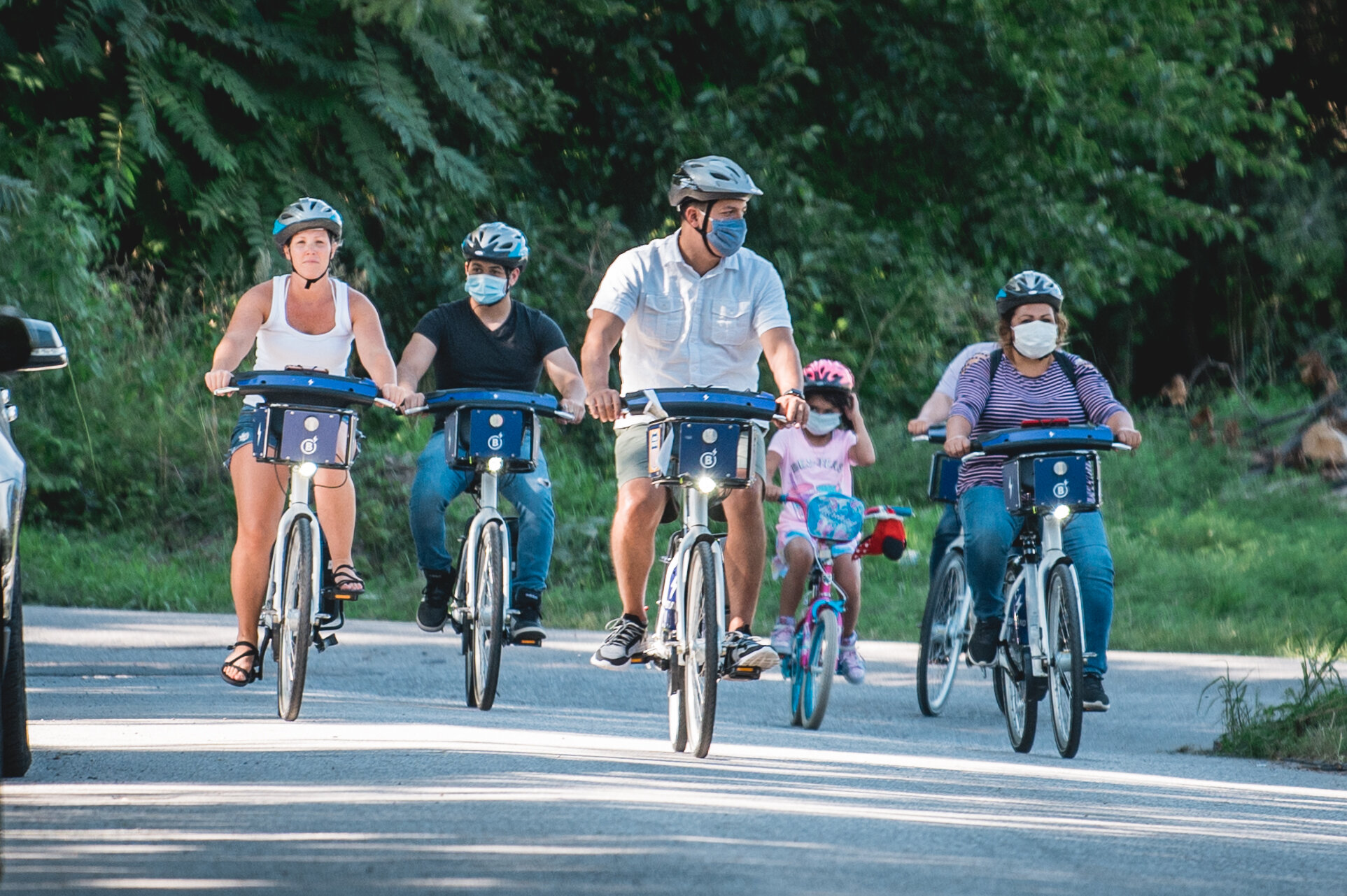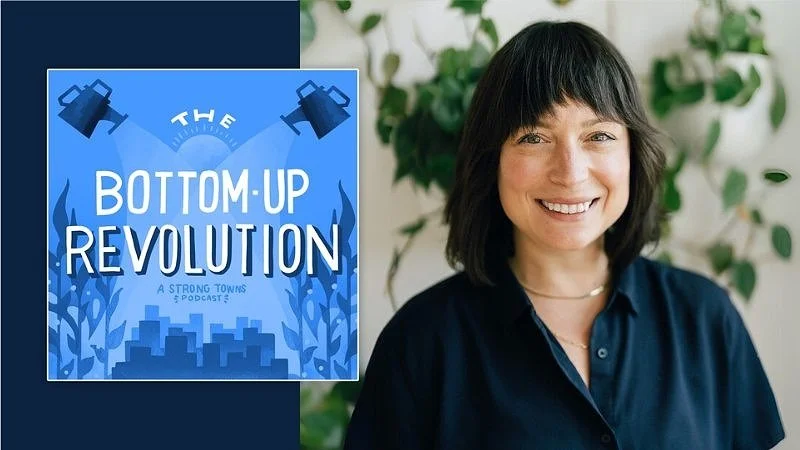4 Strategies for Meaningful Community Engagement During a Pandemic
Neighborhood residents discussing sidewalk and other improvements with organizers from Canopy South in South Omaha, NE.
Planners and community developers are no strangers to changes in timelines and the need to be nimble, yet the onset and lasting duration of the pandemic have shifted stopgap solutions into necessities. Meaningful community engagement and public participation strategies are at the heart of inclusive and successful revitalization projects. Still, traditional methods are bound by ever-changing health directives, and digital divides make shifting online a constrained substitute for traditional meetings and events.
If a bright spot is available, however, these challenges have presented an opportunity for reflection and innovation as we reevaluate the ways in which we engage our communities to ensure they are citizen controlled and empowered, now and in a post-pandemic future. Surprisingly, some of the most meaningful methods are often the least resource-intensive and require a grassroots approach, bringing us back to the basics of purposeful engagement.
While current public health and safety directives impose some limitations on engagement activities, meaningful and safe opportunities to connect are indeed possible. To do so, organizers should keep in mind four key strategies: 1) meet people where they are, 2) place first, data second, 3) add more seats to the table and 4) invest early in visible community improvements.
1. Meet People Where They Are
We often hear the expression, “meet people where they are,” but forget to take the phrase literally. With meeting capacities capped, hitting the pavement may be the best alternative to large, in-person gatherings. Starting these “Community Conversations” throughout the neighborhood—on sidewalks, at parks and outside grocery stores—provides an opportunity to dig deeper and fill in important contextual blanks, which are difficult to address with sizable groups and through surveys. Moreover, when residents determine the direction of these conversations, community developers are shifted from their own agenda of priorities to those held by the community. Simple and effective, all it takes is 10 minutes meeting residents where they are to learn what matters most.
Getting Started in Your Community
Identify the places residents frequent most, such as parks and businesses, to initiate conversations.
Take advantage of optimal weather days when the majority of people are likely to be active and comfortable sharing a brief conversation outdoors.
Have a handful of open-ended questions ready, but residents should ultimately determine the direction of the conversation.
For residents in a hurry, provide additional opportunities to give feedback, maximizing the organizer’s time in the community. Seeing responses from others, specified questions and visual prompts can also help get conversations started.
2. Place First, Data Second
Gaining feedback is an integral component to developing partnerships and establishing community priorities; however, framing events for the sole purpose of data collection can limit our ability to truly listen. Instead, let place become the catalyst for conversation, producing the qualitative data necessary for decision making. Additionally, activity and place-based events allow for social distancing-friendly engagements and organic discussions.
Residents join nonprofit Canopy South and partners, Heartland B-cycle, Heartland Workers Center, and Metropolitan Area Planning Agency for a bike ride through their neighborhood in South Omaha, NE. During the event organizers gathered feedback about the park, streets, and neighborhood improvements.
For example, for the planner interested in neighborhood mobility, hosting a bike ride allows for moments of “show versus tell” where residents identify needs and wants in real-time while organizers experience conditions firsthand. General responses such as, “Fix the streets and make them safer,” shift to more comprehensive and actionable observations. Walking the neighborhood in small groups serves a similar purpose. Talking about better lighting and street repairs can be helpful but navigating a challenging sidewalk and experiencing an area with low visibility can make all the difference. Organizing the event itself can even bring awareness to accessibility and potential improvements.
Getting Started in Your Community
Get on a “human-level” for place-based engagement activities to allow for real-time interaction with space, resulting in more thoughtful and detailed input.
Hold events throughout different seasons to provide insight into changing conditions and community needs.
Host smaller, more frequent place-based activities for in-depth dialogue.
3. Add More Seats to The Table
A full community meeting, neighborhood event or even a successful survey can give organizers a false sense of scale and inclusivity while overlooking the perspectives of a sizable portion of the population. Seniors, and particularly youth, are often left out of pivotal planning discussions. Yet, by adding more seats to the table of perspectives, along with developing to accommodate disparate groups, community developers yield the most inclusive results—to the benefit of all residents. Also essential when identifying and expanding outreach to more diverse populations, are partnerships with local organizations and educational institutions.
Getting Started in Your Community
Partner with after school and internship programs when engaging youth as these organizations have regular meeting times, virtual capabilities and allow for smaller, targeted groups.
Leverage technology with younger populations through apps and video conferencing.
Enlist higher education institutions and historical societies to conduct oral histories with seniors and immigrant communities to deepen cultural understanding and help guide inclusive development.
Incorporate art and place-based activities as mechanisms for gathering feedback.
: South Omaha, NE interns with the Siembra Nebraska program discuss neighborhood improvements to parks and nearby vacant lots.
4. Invest Early in Visible Community Improvements
Art and beautification are easily categorized as a luxury in a planning budget or reserved for when development is well underway, yet there is no time like the present to invest in making spaces visually appealing and engaging. Beautification of public spaces, street and sidewalk improvements, and public art installations are low hanging fruit investments, which can build community awareness and trust in future projects.
Community responses to the question, “When I dream about my ideal neighborhood, it has…,” written on a chalkboard cube and art installation at Miguel Keith Park in South Omaha, NE.
Often community developers are disincentivized from prioritizing these activities early out of concern for their longevity and potential vandalism. However, taking the first step and demonstrating shared value in public spaces can drastically change perceptions and tap into existing community pride—foundational for relationship building and recognizing existing community identity.
Getting Started in Your Community
Utilize interactive public art installations as an opportunity to spark conversations and gain community feedback.
Engage local artists to deepen connections within the community while generating financial investment in the area.
Test temporary changes to the built environment, like pop-up seating and bike lanes, with tactical urbanism.
Maximize efforts by connecting projects to place-based engagement events, such as a park clean-up.
Adapt to seasonal conditions through weatherproofing, seasonal plantings, lighting, etc.
The pandemic has put many plans on pause, but connecting with our communities must continue. By simplifying and humanizing our strategies, meaningful and purposeful engagement is possible. While a return to a reflection of normal is on the horizon, by holding onto lessons learned, we can be more empathetic and effective community builders—led by the communities we serve.
About the Author
Alexandra Moran, MS is the Project Coordinator for Canopy South, a nonprofit organization leading neighborhood transformation in South Omaha using the Purpose Built Communities Model for holistic revitalization: high-quality mixed-income housing, an effective cradle-to-career education pipeline, and comprehensive community resources to ensure community vibrancy.















Eric Higbee is a landscape architect who teaches university courses on community engagement and works on community design and planning projects through his award-winning landscape architecture practice.